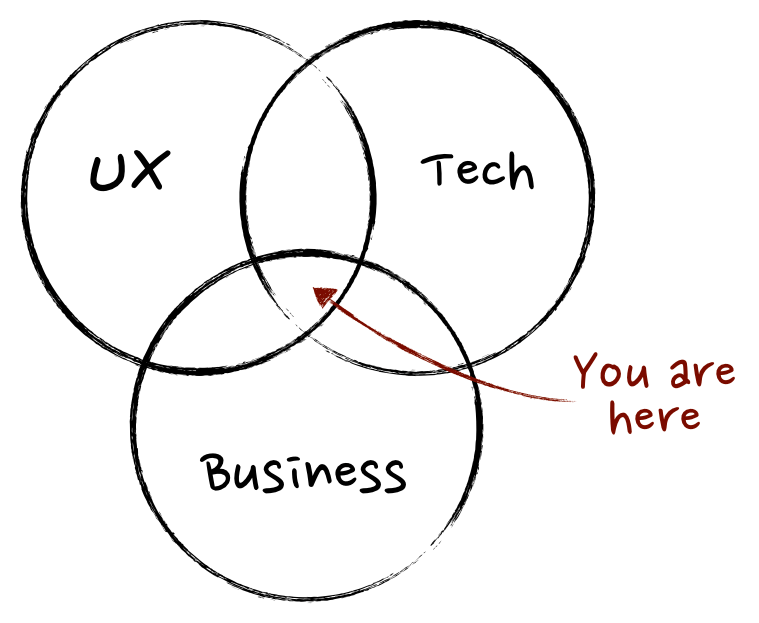Being a product manager is hard. Very hard. Let’s find out from the experts how to make it a little easier. Squeezed in between the intersection of business, technology and user experience, product managers are constantly under pressure.

Great product managers must have deep experience in at least one, literate in all three, and fluent with the practice of each. Evangelist, arbiter, organizer, negotiator, writer, listener, and herder of cats. You wear all these hats. As with all responsible roles, years of experience doesn’t guarantee you won’t make mistakes, it just means you’re better prepared.
We’ve interviewed hundreds of product leaders for the book Product Leadership, as part of our Product Hero series, and as guests of our podcast. We ask each of them, “what advice would you have for other product managers?”
These are their responses.

NIHITO: Nothing Interesting Happens In The Office
Understanding customer’s problems generally doesn’t happen when you’re staring into the screen on your desk. There’s obvious value in pouring over quantitative research but it’s never enough.
Frere believes that going out into the environments where his end users interact with his product, gives him an edge. Hearing directly from your customers, in their environment, is one of the fastest ways to learn and improve your product.
Flywire’s product teams remain customer focused to maintain their competitive advantage.
Product managers, and their teams, get so bogged down by triaging bugs and feature requests, writing requirements, test plans and user stories, or managing release schedules that it’s easy to forget the customer. Just seeing things from a different perspective or out “in the wild” has deep and competitive benefits.

Get Close to the User
The moment you think you have all the answers you are doomed. Product management requires extreme curiosity and the assumption that you don’t have the answers.
Personal biases need to be overcome to remain objective.
It’s hard not to look at your products from your own perspective, but you are not your customer. This objectivity might even be harder if you’re the inventor or a user of the product. Setting aside your opinions is the first step towards real empathy with your users. Only by striving to really understand your users will you be able to solve their problems.
Curiosity is required to understand your users’ problem(s) better than anything else. It also requires you to understand why they’re not getting the solution to their problem elsewhere. What has prevented them from solving it to this point? Whoever gets closest to the customer wins.

Listen More and Talk Less
Getting out of the office get you closer to the user. Once you’re there you need to take the opportunity to actually listen to them. It sounds obvious, but listening — REALLY listening — is a critical skill that is infrequently practiced.
There are numerous examples of what happens when companies don’t listen to users, including Blackberry, Henry Ford, and Lego. In a highly publicized blunder, Netflix made the executive decision to split their DVD and streaming business, while charging customers the same for both. For those customers that wanted to use both services, this move effectively doubled their subscription cost. They were not happy. This tone-deaf decision resulted in Netflix losing 800,000 subscribers.
In many of these cases, the common executive excuse was customers don’t know what they want. Ford remarked, “If I had asked people what they wanted, they would have said faster horses.” Whether Ford uttered those words or not, what we should hear is something like “getting from point A to point B is too slow.”
They key is often asking the right question.
Don’t ask users what they want, ask them about their goals and frustrations. What they like and dislike about your product (or what they currently use to try and solve the problem). The only way to make great products is to invest time in listening to your customers to understand their problems and their needs and not necessarily their wants.

Know Your Team
Getting to know your team leads to building better products and experiences. This doesn’t just mean your immediate team. Build relationships with the broader team beyond just product, design and engineering. Understand the way you communicate and interact with each of them.
Most product team challenges are people challenges — prioritize people over process.
Everyone will bring different biases, perspectives, communication skills and approaches to the conversation. Individuals bring their own interests and their own skill sets to the table that you can lean on and learn from.

Write It Down
Yoo recommends that PM’s collect their experiences with the products they use day-to-day. Her recommendation is to use a journal. These experiences will help product leaders craft new ideas but also steer them away from potential pitfalls in creating their products.
The act of writing down product experiences sharpens your observation skills.
We all make lists. Books we want to read (and never get to), movies we’d like to see (ditto) and more. We all have favorite products that we use (or would like to use) every day. One thing all of those products have in common is a product manager/team of people behind it thinking about what needs to come next for the product.
Keeping track of your product thoughts is a good way to demonstrate and grow your appreciation for the role and what others are doing. And it’s a good way to remind yourself to think about what’s next for your own product.

Prioritize The Right Things
On the list of top challenges for product managers, prioritization rises to the top every time. Deciding what belongs in your product and when to ship it, is regularly the most difficult part of the day. Product managers themselves say as much — The biggest challenge to getting things done is knowing WHAT to get done.
These priorities don’t exist in a vacuum.
Everything upstream from that decision affects the choices leaders make. From the product vision to the strategy, they all trickle down to the prioritization process. Leaders and managers can only rank their tasks and efforts by where they are headed — and that’s defined by your product’s vision.
Like any journey, a clear, meaningful destination makes the individual steps infinitely easier. A product vision should help you, your team and your customer visualize what this better world looks like.
Fortunately there is a radical and simple approach to product prioritization that guides you through a few basic steps towards a clear, concise vision.

Just Ship It!
LinkedIn co-founder Reid Hoffman once famously wrote, “If you are not embarrassed by the first version of your product, you’ve launched too late.” Whether you subscribe to this approach depends on a number of things, including the stage of your business and the product that you are shipping. A half-baked self-driving car might not be a great idea.
Shipping early and often provides essential customer feedback and insights that can never be gained by research or testing alone.
The point, of course, isn’t to ship lousy stuff (with apologies to Seth Godin), but rather to place an emphasis on getting your product in the hands of users. This allows collecting feedback to happen faster. You need to watch them use, or struggle with, your product in multiple stages of completeness.

Connect With The Community
Ferranto knows that product is a team sport. She’s the driving force behind many of Boston’s product groups. From local groups like Boston Product Management Association and Boston Women in Product to national and international groups like Mind the Product, there are no shortage of opportunities to surround yourself with other product leaders. Be a part of the product community, go to meetups, or find the product-focused organization and learn from them.
Part of being a good PM is sharing with your community.
No one person has all the answers, but maybe our collective experiences can get us closer to the knowledge we seek. You just have to find the people that hold those insights.
What advice would you give to your product manager colleagues?
If you want to read more on leadership, you can download a free chapter of the best selling book Product Leadership: How Top Product Managers Launch Awesome Products and Build Successful Teams.
